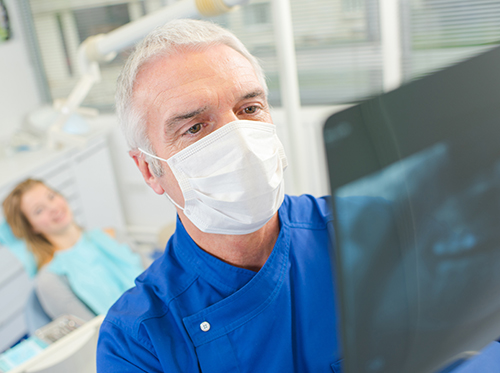
No one really looks forward to a wisdom tooth extraction, even a straightforward one. Fortunately, you can be confident that your oral and maxillofacial surgeon has the experience and the skill to make your extraction experience as safe and comfortable as possible.
But what happens when your situation is not quite so straightforward? Dr. Ford and Dr. Guter and our team have the experience and the skill to diagnose and treat these more complex extractions as well.
One of the potential complications with an impacted wisdom tooth is its close proximity to the Inferior Alveolar Nerve (IAN) of the jaw. When the roots of the impacted tooth are fully developed, they can rest very close to, put pressure on, or, in rare cases, even wrap around this nerve.
Why is this a problem? Because these nerves supply feeling to the lower lip, gums, chin, and teeth. If a nerve is damaged during extraction, a patient might be left with pain or numbness in these areas, which can affect sensation, speech, and eating. While this nerve damage is usually temporary, in rare cases it can be permanent.
But an impacted tooth, left alone, can also have serious consequences—pain, infection, and damage to neighboring teeth and bone. So what’s the answer in this complicated case?
Talk to Dr. Ford and Dr. Guter. We have the training and skill to detect any potential nerve involvement when you need a wisdom tooth extraction, and we have a procedure to help prevent damage to the nerve if it lies too close to the roots. The coronectomy is a specialized surgery used only to treat impacted teeth when the nerves of the lower jaw might be compromised.
What is a coronectomy, exactly? The tooth can be thought of in two distinct segments—the crown, which is the part of the tooth that rises above the gum when the tooth erupts, and the roots below, which anchor each tooth in the jaw. A “coronectomy” means the removal (“ectomy”) of the crown (“corona”) of the tooth.
In this procedure, we will divide the tooth into two parts. After making a small incision to expose the tooth, the crown will be removed, and the root section left in the jaw. When the procedure is completed, the incision in the gums will be closed with sutures. Recovery is much like recovery for any other tooth extraction.
Once the coronectomy is completed, you might be asking, “What happens to those roots that were left behind?” Another good question!
- Very rarely, the roots become infected or cause irritation to surrounding tissue and will need to be removed.
- Occasionally, root fragments can start to emerge through the gums, just as a whole tooth would. But since they must move away from the nerve in order to erupt, they can be extracted without endangering the nerve.
- The most common result? The remaining root segment becomes permanently encased by bone tissue within the jawbone, never to cause problems again.
Are there times when, even though a wisdom tooth is bordering on a nerve, this procedure might not be advisable? Yes. Infection and decay in the tooth, tooth mobility, periodontal disease near the tooth, a horizontal tooth (where sectioning the tooth could damage the nerve), and other conditions might mean that a coronectomy is not possible. In that case, Dr. Ford and Dr. Guter can discuss further options with you.
No one really looks forward to wisdom tooth extraction. Fortunately, even in complicated situations, your oral and maxillofacial surgeon has the experience and the skill to provide the answers you need for an extraction experience that is as safe and comfortable as possible.
Any more questions? Contact our Virginia Beach, VA office to see if a coronectomy is the answer for you.






 Website Powered by Sesame 24-7™
Website Powered by Sesame 24-7™